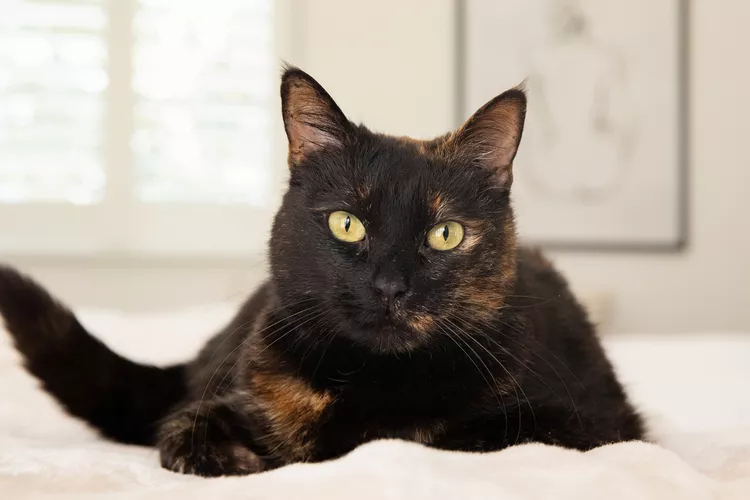- 01 of 08
Most Tortoiseshell Cats Are Female; Males Are Extremely Rare
Like calico cats, you'll find most tortoiseshell cats are female. That's because the same chromosomes that determine their sex also determine the colors in their coats. The female sex chromosome (X) also carries the genetic code for orange or black coat colors; the male sex chromosome (Y) does not carry information on coat color.
Because females have two X chromosomes, they have two sets of genetic information that can determine their coat color. The embryo shuts off one X chromosome in each cell, resulting in orange and black color variations in their coats.
Because a male cat has one X chromosome and one Y chromosome, he'll only be orange or black—not both.
In very rare cases—about 1 in 3,000—a male tortoiseshell cat can be born with two X chromosomes and one Y chromosome. In 2014, a Scottish cat rescue welcomed tortoiseshell kitten Harry into the fold—a feat so rare it made the news.
Unfortunately, male cats with XXY Syndrome are sterile and often have serious health issues, resulting in significantly shorter lifespans than female torties.
Continue to 2 of 8 below - 02 of 08
Torties (Perhaps) Have a Distinct Temperament
Although tortoiseshell cats aren't a specific breed, some people believe they have a specific temperament.
In a study conducted by the University of California, Davis, Veterinary Medical Teaching Hospital, researchers pondered the link between a domestic cat's coat color and their behavior. Tortoiseshell cats, along with calicos and "torbies," were the main focus of the study.
After the study was published, speculation spread that tortoiseshell cats have a distinct, somewhat sassy temperament, which was quickly coined "tortitude." Anecdotally, many tortie parents agreed that their cats were high-energy, sassy, and even slightly aggressive.
But the study's researchers actually didn't find a distinct link between coat color and behavior, temperament, or personality.
Maybe "tortiude" was just confused with regular old cases of catitude.
Continue to 3 of 8 below - 03 of 08
Tortoiseshell Cats Are in Many Breeds
Mixed breed and purebred cats can sport the tortoiseshell coat pattern, including:
Continue to 4 of 8 below - 04 of 08
Tortoiseshell Cats Are Considered Good Luck
Across the internet, you'll find plenty of auspicious legends about tortoiseshell cats. They're considered to be signs of good luck in several countries, though the backstories are mostly mythical.
- In Japan, people believe tortoiseshell cats can protect ships from ghosts and shipwrecks.
- English folklore says rubbing a tortoiseshell cat's tail on a wart will cure the affliction, but only, potentially, in the month of May.
- In the United States, tortoiseshell cats are believed to be "money cats" that will bring good fortune into the home.
- An extremely rare male tortie joining your home? That's more good luck in Scotland and Ireland.
Continue to 5 of 8 below - 05 of 08
They're Named After Tortoiseshell Material
Tortoiseshell—from real, live tortoises—served as material to produce high-end jewelry, eyeglasses, and home decor prior to the 1970s. Tortoiseshell cats were named after this material because their coats are reminiscent of the colors and pattern.
Since tortoise populations were decimated worldwide because of such high demand, the use of the material was banned by the CITES treaty and synthetic tortoiseshell was developed.
Continue to 6 of 8 below - 06 of 08
Tortoiseshell Cats Can Also Be "Torbies"
When you cross a tortoiseshell cat's coloring with a tabby's stripes, you get a "torbie." You may also hear them being referred to as "tortoiseshell tabbies" or “striped torties.” They have gorgeous, colorful coats with distinctive stripes with lots of variation.
Continue to 7 of 8 below - 07 of 08
President Ronald Reagan Owned Tortoiseshell Cats
President Ronald Reagan and First Lady Nancy Reagan didn't keep tortoiseshell cats Cleo and Sara at the White House in the 1980s. Instead, the two kitties stayed at their California ranch.
Continue to 8 of 8 below - 08 of 08
Tortoiseshell Cats Have Two Types of Fur
Although tortoiseshell coats are most commonly a combination of ginger and black, they can also have hints of cream, orange, or gold. The colors are either "bridled" (look like they're woven together) or "patched" (form in large patches all over the body).
In addition, their coats can be chimera or mosaic, with mosaic being much more common because chimera happens when two embryos fuse in the womb. The chimera pattern features a different color on each side of the face, with the two colors separated clearly along a line. The mosaic pattern’s colors are mixed or swirled together all over the face and body.
-
How much do tortoiseshell cats cost?
If purchasing a purebred cat with a tortoiseshell coat, the price will depend on the breed, as some are more expensive than others—some cost hundreds while others cost thousands of dollars. Or, you can adopt one, whether purebred or mixed breed, more affordably. Tortoiseshell cats aren't rare (except for male ones, of course), so let your local shelter or rescue know you're looking for one, as they can probably find one for you to adopt.
-
What is the difference between a tortoiseshell and a calico?
They do look alike, but a tortoiseshell usually has two colors instead of the calico's three. Also, a tortie's coat colors are usually more blended together while a calico's coat features more patches.
-
What do I do if my cat has tortitude?
If your tortoiseshell cat seems to have a little more attitude than other cats, ask your veterinarian if you should care for her any differently. You can also try to eliminate stress and set aside plenty of time for play and exercise.
-
Are tortoiseshell cats very friendly?
Some pet parents describe their torties as sassy, but every cat is an individual with their own unique personality. Generally, tortoiseshell cats are affectionate, cuddly, and social companions who are friendly and fun, just like other cats.




















